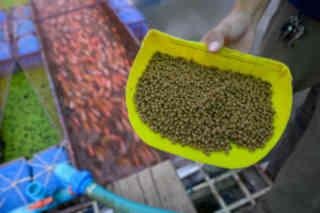In-pond raceways are a vital tool in aquaculture. Aquaculture is the breeding, raising and harvesting of fish, shellfish and aquatic plants. In-pond raceways are the structures that contain the fish, allowing farmers to create healthier habitats by simulating natural currents, containing feed and removing excrement.
WISHH aquaculture advisor in Cambodia, Leonard Rodgers, Ph.D., used his decades of experience to adapt raceway designs he worked with at Auburn University to meet the southeast Asian nation’s unique challenges. The resulting IPRS is a breakthrough technology that continues to improve.
The IPRS also help farmers manage fish in Cambodia, where they traditionally use homemade feeds with rice bran as the main ingredient. “It’s low in protein so you have to feed a lot of it to put muscle on the fish,” says Rodgers. “An in-pond-raceway helps the farmers monitor their biggest cost outlay, which is feed. Cambodian fish farmers’ feed costs usually constitute 70% to 90% of their cost of production. In an IPRS, farmers can monitor the feed as they put it in and make sure they don’t overfeed.”
Meanwhile, WISHH is working with Cambodian feed mills to manufacture soy-based feeds for aquaculture. One of these feed mills is already a U.S. Soy customer and showed the U.S. soybean growers the mill’s multi-million-dollar expansion. Through WISHH’s Food for Progress Project in Cambodia, WISHH recently sent a technical expert to the mill to work with them on their extrusion equipment that serves their production of feeds for fish, swine, duck and more.
USB supports WISHH to enhance focus on issues that incorporate and support the supply, demand, communications and education goals of USB’s new strategic plan in the priority areas of infrastructure and connectivity, health and nutrition, and innovation and technology.
“Engagement in global food security conversations gives U.S. Soy a seat at the table in nontraditional circles like Cambodia,” Lisa Humphreys, senior director of content management and brand stewardship for USB, says. “This engagement is also a win-win for U.S. soybean farmers and developing and emerging economies.”
While in Cambodia, USB Director Greg Greving also represented U.S. soybean growers as a speaker at the Third International Sustainable Agricultural Intensification and Nutrition Conference (called SAIN3) The WISHH and USB-sponsored conference allowed university and other agricultural experts from throughout the world to hear how U.S. soybean growers are committed to conservation and sustainability at the same time they increase soybean productivity.
He shared how his family has increased soybean yields to about 2.5 metric tons of soybeans per acre at the same time they implemented new sustainability practices such as cover crops for soil health. He also described how USB puts a priority on health and nutrition.
Checkoff promotes floating feed
WISHH is working to switch farmers from their traditional feeds that are still widely used today. Homemade fish food consisting of rice bran, groundfish parts and some vitamins or minerals as the primary diet for multiple species. The food was then dumped into a pond, causing water quality issues and improper nutrition for the fish.
“They don’t know how much performance they are getting out of their fish — something that we call the feed conversion ratio,” Jim Hershey, Chief of Party for the CAST Cambodia project, says. “Modern animal agriculture is about feed in and meat out, and properly formulated commercial feed is, frankly, always best.”
Funding for USDA projects typically lasts five years. With that in mind, Perry says that WISHH helped create the Cambodian Aquaculturist Association (CAA). The CAA offers a sustainability strategy to carry on the work of improving aquaculture and soy usage in Cambodia after the project ends in 2023.
State and national checkoffs spur innovation
Perry says that funding from state soybean boards and the soybean checkoff is used to leverage dollars provided by the USDA.

The Nebraska Soybean Board provided funding to WISHH to improve aerator technology for the in-pond raceways being implemented in Cambodia. The aerators improve oxygen rates in the in-pond raceway systems, promoting fish health. Missouri provided checkoff funding to engineer the special Cambodian raceways.
“It’s like anything else that you’re trying to sell or promote — you need to keep hitting the bricks and keep getting them the stuff that they need,” Greg Greving, a farmer-leader from Nebraska, says after visiting Cambodia with other WISHH trade team members. “WISHH could not operate without the checkoff. When you go over there, you see what the checkoff is doing, and that gives you the passion and the drive to keep going and pushing and hitting the bricks to increase demand.”
Success stories across the country could lead to establishing and expanding a market for U.S. soybeans in the future. Cambodia is a growing market for U.S. agricultural exports, with $72.7 million in sales in 2020 — an increase of 474% over the past 10 years. In 2021, the United States opened its first U.S. Department of Agriculture (USDA) office in Phnom Penh to support the growing agricultural trade between the two countries.
“We are working with feed mill operators and the exporters to ensure that U.S. soybeans are available. Otherwise, they’re going to look elsewhere,” Brad Doyle, president of ASA, says after touring an aquaculture farm in Cambodia. “We want to put money in their pockets so they can expand their business and feed their families. I think that is critical. It will bring in more soybeans, but they have to have the availability of U.S. soybeans.”
Gerry Hayden, immediate past chairman of WISHH and a Kentucky soybean farmer, sees Cambodia as a powerful export market opportunity for U.S. soybeans in the next decade.
Click here to see more...